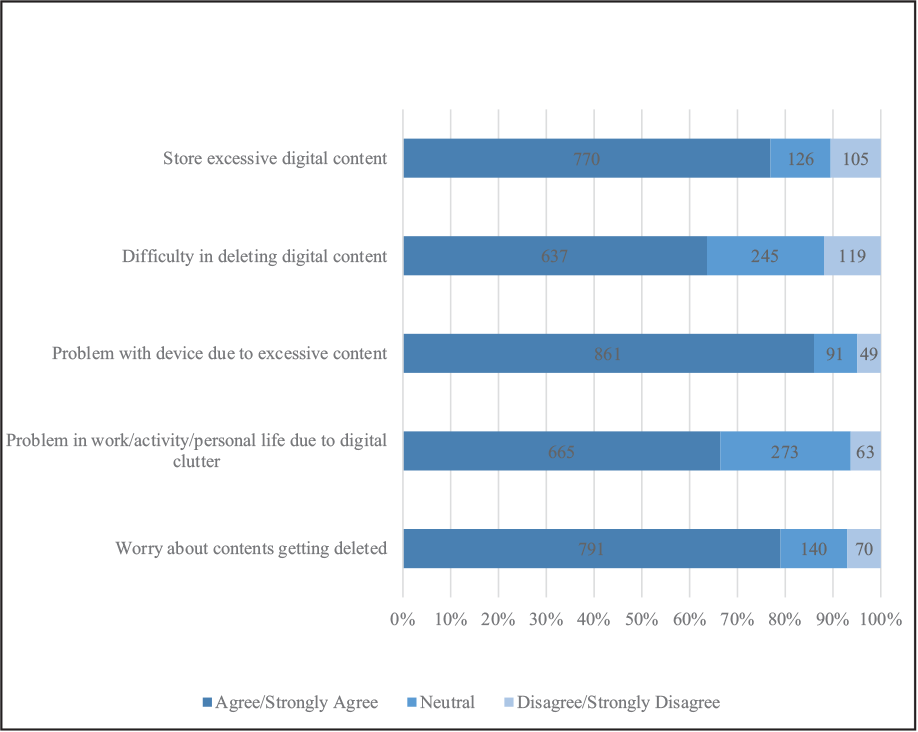Translate this page into:
Cyberhoarding – A New Concept and Its Recognition: Result from a Survey

*Corresponding author: Sharmila Sarkar, Consultant Psychiatrist, Apollo Clinic, Jessore Road, Dum Dum, Kolkata, West Bengal, India drsharmilasarkar@gmail.com
-
Received: ,
Accepted: ,
How to cite this article: Karmakar S, Chakraborty A, Sarkar S. Cyberhoarding - A New Concept and Its Recognition: Result from a Survey. Bengal J Psychiatry. 2024;29:44–7. doi: 10.25259/BJPSY_3_2024
Abstract
Objectives:
To assess the presence and severity of cyberhoarding the present study was conducted.
Material and Methods:
It was an online survey. Apart from basic demographic questions five cyberhoarding related questions whose responses were framed in a 5- points Likert scale was send randomly to1400 adult.
Results:
Out of 1001 participants, we noted majority (77%) tended to store excessive data, 63.6% had difficulty in deleting these data after their intended use, 79% of participants got anxious about the thought of these data getting erased, and 66.5% had faced some stress/problem in their personal life/work due to digital clutter.
Conclusion:
Our study showed that the prevalence of digital hoarding behavior was high in our country, and there was a need for further research and development of specific assessment tools for its recognition.
Keywords
Cyberhoarding
Digital hoarding
Hoarding disorder
Digital clutter
INTRODUCTION
Cyberhoarding digital hoarding or e-hoarding is a relatively new concept, which may be defined as ‘the excessive acquisition and reluctance to delete electronic material no longer valuable to the user’.1 Simply put, it is the unnecessary saving, archiving, or storing of digital files like documents, photos, videos, songs, recordings, e-books, software/applications, browser tabs, excessive desktop items, and even emails and chat history in the hope of utilization in the future. The term is increasingly common in newspapers, blogs, and magazines.2,3
Diagnostic and Statistical Manual of Mental Disorders, Fifth Edition (DSM-5) recognizes hoarding disorder as a separate entity. The essential feature is a persisting difficulty in parting with possessions regardless of their actual values, which creates clutter and hampers normal living and activity.4 In cyberhoarding, the clutter is in cyberspace or digital storage space instead of a physical living area but retains the essence of hoarding disorder. In the era of digitization, India is not far behind, and digital hoarding is on the rise. As reported by a reputable antivirus software firm, users typically install 12 Android applications on their phone every month but delete only 10, adding 2 of them every month. They also reported that on computers, 30% of installed software is never used.5
The first clinical study regarding digital hoarding was published in 2015. It was a case report from the Netherlands in which a 47-year-old man preoccupied with hoarding digital pictures was described, which interfered with his daily functioning (he stored nearly 1000 pictures every day).6 Following that, a few studies have been undertaken to investigate this potential problem, but none have been reported in India to date, the lack of standardized assessment tools being one of the many obstacles.7–10 We aimed to investigate the magnitude of this potentially disordered behavior in the Indian setting.
MATERIAL AND METHODS
This online survey was conducted between July 2022 and June 2023. After obtaining permission from the Institutional Ethics Committee, a pretested questionnaire form was sent to 1400 adult recipients who were chosen through simple random sampling from the contact list of us and our colleagues from the Department via email, and the recipients were requested to mail back with the responses if they consented to be included in our study. Basic demographic details like age and gender were also recorded.
Each of the following questions was scored in a 5-point Likert scale format, where the scoring is: +2: Strongly Agree, +1: Agree, 0: Neutral/Neither agree nor disagree, −1: Disagree, −2: Strongly Disagree.
Q1. Do you tend to collect and store a large number of digital materials (documents, books, songs, photos, videos, applications) on your computer/tablet/phone?
Q2. Do you find it difficult to discard/delete these digital materials even after they are no longer in use?
Q3. Have you ever faced a shortage of storage space/device slows down considerably/device hangs because of excessively stored digital content?
Q4. Do you face difficulty/problems/distress in your work/activities/personal life because of these digital clutters?
Q5. Does the possibility significantly unsettle/worry you if somehow these unused digital contents get deleted from your device?
Out of 1400 recipients, 1001 responded back with valid responses. Data from those were included in the analysis.
RESULTS
Out of 1001 participants, 546 were male, and 455 were female. The mean age of the participants was 31.47 ± 7.84 years. Table 1 shows the distribution of participants based on their responses to each question item. Figure 1 shows a graphical representation of the distribution of participants based on their responses according to their agreeability in each of the questions using a bar diagram.
| Questions | No of persons in each response group (Percentage in Brackets) |
||||
|---|---|---|---|---|---|
| +2: Strongly Agree | +1: Agree | 0: Neutral | -1: Disagree | -2: Strongly Disagree | |
| Q1 | 315 (31.5%) | 455 (45.5%) | 126 (12.6%) | 65 (6.5%) | 40 (4.0%) |
| Q2 | 94 (9.4%) | 543 (54.2%) | 245 (24.5%) | 91 (9.1%) | 28 (2.8%) |
| Q3 | 539 (53.8%) | 322 (32.2%) | 91 (9.1%) | 43 (4.3%) | 6 (0.6%) |
| Q4 | 175 (17.5%) | 490 (49.0%) | 273 (27.3%) | 49 (4.9%) | 14 (1.4%) |
| Q5 | 273 (27.3%) | 518 (51.7%) | 140 (14.0%) | 34 (3.4%) | 36 (3.6%) |

- Distribution of participants based on responses to each question according to their agreeability (n = 1001).
DISCUSSION
In our study, a significant proportion of the participants (77%) responded that they tended to collect and store a large number of digital content on their devices (Agreed or Strongly Agreed). 63.6% had difficulties in discarding or deleting these contents even after they were no longer in use. 86% of participants faced difficulties with the functioning of their devices due to excessive content, and 66.5% had faced problems in their work or personal life due to these digital clutters. Also, 79% of participants got anxious about the thought of these contents getting deleted from their devices. These numbers signify that the majority of our participants had at least some degree of tendency towards cyberhoarding. But, because of its non-physical nature, this activity did not readily get attention as a medical condition. Also, with the advent of greatly facilitated storing capacity and expansion of cyberspace, e-hoarding tends to be a slowly moving progression.11
However, digital hoarding behavior readily fulfills criteria A (question 1) and B (questions 2 and 5) for hoarding behavior as per DSM-5. Criteria C is fulfilled if we consider cluttering in virtual space. Criteria D has also been reported in our study, as with questions 3 and 4, and also in the case study from the Netherlands.4,6 Hence, digital hoarding has the potential to be classified as a special type of hoarding disorder. Some associations between digital and physical hoarding behaviors have also been reported.7–9 In their study, van Bennekom et al. suggested that digital hoarding be incorporated as a new subtype of hoarding disorder.6
Studies have used non-specific assessment tools for cyberhoarding. For example, Luxon et al.7 had used Discrete Emotions Questionnaire (DEQ)12, Obsessive Compulsive Inventory-Revised (OCI-R)13 & Saving Inventory-Revised (SI-R)14, and van Bennekom had used SI-R, Saving Cognitions Inventory15, Clutter Image Rating16 & Compulsive Acquisition Scale (CAS)17 in their assessments.6,7 We also have used non-standardized and non-specific questionnaire in our survey. Specific scales need to be developed to screen and diagnose this condition properly. Fortunately, one such tool named Digital Behaviors Questionnaire (DBQ) is underway.18
No specific treatment has till now been described, and management is based on principles of Cognitive Behavior Therapy for object hoarding.6
CONCLUSION
With technological advancement humans are periled to its darker side, and cyberhoarding seems to be one of the threats. Our study has shown that digital hoarding behavior is highly prevalent in our country, too. Specific assessment tools should be developed to diagnose this potentially problematic condition, and more research is needed to quantify the problem to be abnormal and require treatment.
Ethical approval
The research/study approved by the Institutional Ethics Committee at Calcutta National Medical College, Kolkata, number EC-CNMC/2023/183, dated 25th March 2023.
Declaration of patient consent
The authors certify that they have obtained all appropriate patient consent.
Financial support and sponsorship
Nil.
Conflicts of interest
Soumen Karmakar and Sharmila Sarkar are on the editorial board of the Journal.
Use of artificial intelligence (AI)-assisted technology for manuscript preparation
The authors confirm that there was no use of artificial intelligence (AI)-assisted technology for assisting in the writing or editing of the manuscript, and no images were manipulated using AI.
REFERENCES
- ELGL [Internet]. https://elgl.org/digital-hoarding-working-to-de-clutter-your-digital-space/. (accessed )
- [Google Scholar]
- 2016. MEL Magazine.. https://melmagazine.com/en-us/story/the-invisible-weight-of-digital-hoarding. (accessed )
- Why it Pays to Declutter Your Digital Life [Internet]. http://www.bbc.com/future/story/20190104-are-you-a-digital-hoarder. (accessed )
- [Google Scholar]
- Diagnostic and Statistical Manual of Mental Disorders (DSM-5®). American Psychiatric Pub 2013:1679.
- [Google Scholar]
- Digital Clutter Can be Dangerous [Internet]. https://www.kaspersky.com/blog/my-precious-data-report-one/14093/.. (accessed )
- [Google Scholar]
- Pinning Our Possessions: Associations Between Digital Hoarding and Symptoms of Hoarding Disorder. J Obsessive-Compuls Relat Disord. 2019;21:60-8.
- [Google Scholar]
- Digital Hoarding Behaviours: Underlying Motivations and Potential Negative Consequences. Comput Hum Behav. 2018;85:54-60.
- [Google Scholar]
- Hoarding and Minimalism: Tendencies in Digital Data Preservation. In:. Proceedings of the 2018 CHI Conference on Human Factors in Computing Systems – CHI ’18. 2018:1-12.
- [Google Scholar]
- Possession Rituals of the Digital Consumer: A Study of Pinterest. Eur Adv Cons Res. ;10:47-50.
- [Google Scholar]
- In: Wikipedia [Internet]. 2019 https://en.wikipedia.org/w/index.php?title=Digital_hoarding&oldid=912559003. (accessed )
- [Google Scholar]
- The Discrete Emotions Questionnaire: A New Tool for Measuring State Self-Reported Emotions. PLOS ONE. 2016;11:e0159915.
- [Google Scholar]
- The Obsessive-Compulsive Inventory: Development and Validation of a Short Version. Psychol Assess. 2002;14:485-96.
- [Google Scholar]
- Measurement of Compulsive Hoarding: Saving Inventory-Revised. Behav Res Ther. 2004;42:1163-82.
- [Google Scholar]
- Development and Validation of the Clutter Image Rating. J Psychopathol Behav Assess. 2008;30:193-203.
- [Google Scholar]
- Compulsive Buying, Compulsive Hoarding, and Obsessive-Compulsive Disorder. Behav Ther. 2002;33:201-14.
- [Google Scholar]
- Digital Hoarding Behaviours: Measurement and Evaluation. Comput Hum Behav. 2019;96:72-7.
- [Google Scholar]







